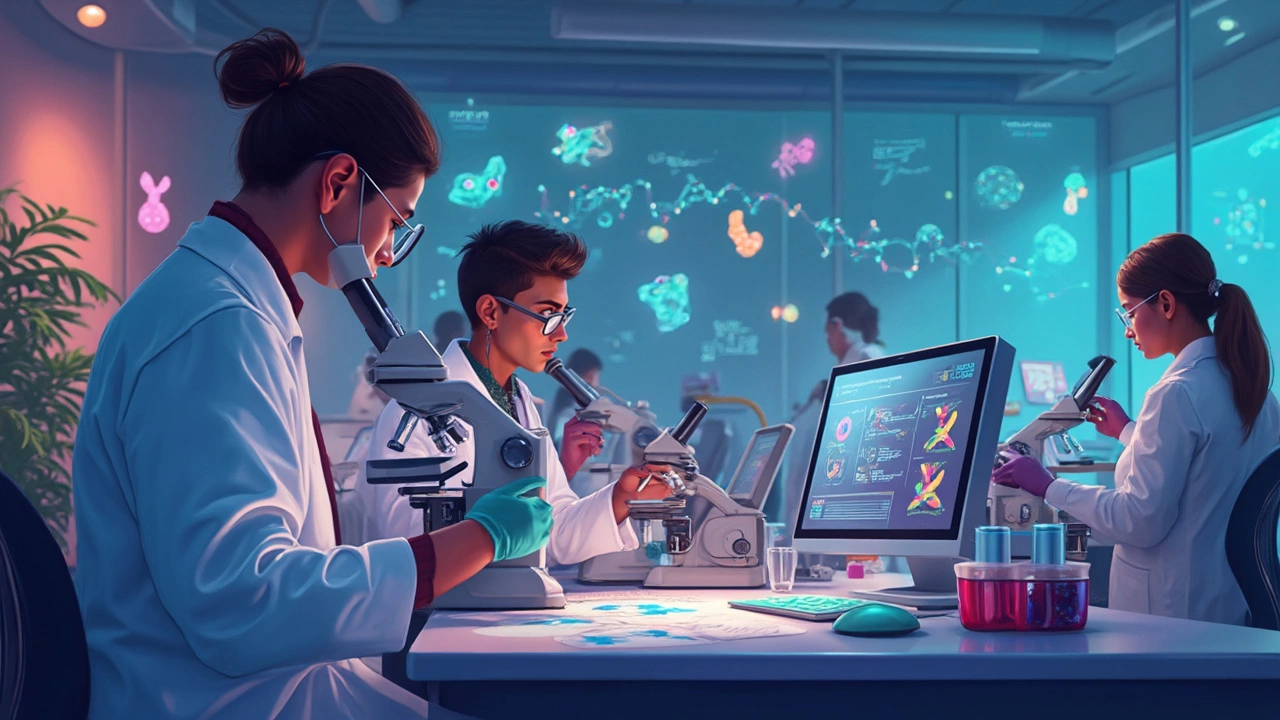The word "cure" gets thrown around a lot, especially when talking about cancer. But here’s the thing—doctors almost never promise a complete cure for every case. Even if all the signs of cancer are gone after treatment, most doctors prefer to talk about "remission." That just means the cancer is under control or has disappeared for now.
Ever wondered why they’re so careful about this? Cancer isn’t like strep throat, where you knock it out with antibiotics and move on. Tumors can come back, sometimes even after years. So, when you hear news stories about a "cancer breakthrough," it doesn't mean there’s a magic pill or shot that works every time for everyone.
Still, lots of cancers today can be treated so well that people live a normal life—or even the rest of their life—without cancer coming back. For some cancers, like certain types of childhood leukemia or testicular cancer, the numbers are really good and long-term survival rates are high. But for others, like pancreatic cancer, it’s still a tough road.
- What Doctors Mean by a Cancer 'Cure'
- The Science Behind Beating Cancer
- Remission vs. Cure: Why It Gets Confusing
- Tips and Hope: What You Can Do Now
What Doctors Mean by a Cancer 'Cure'
Most folks think a "cure" means the cancer is gone, never coming back. But for doctors, the word isn’t that simple. They rarely say someone is "cured" because cancer can be sneaky, hiding out in the body and coming back years later. Instead, the word you’ll hear more often is "remission." That just means doctors can’t find any sign of the cancer right now.
Here’s how it usually works. If your cancer doesn’t come back after five years, it’s a really good sign—especially for certain cancers. But even then, most doctors are careful with the word "cure." Some cancers have a higher rate of returning after those five years, so they play it safe and stick with "remission."
Take a look at this simple table showing five-year survival rates after treatment for some common cancers. These rates help doctors figure out how likely someone is to be "cured," but remember—no one can guarantee the cancer will never return.
| Cancer Type | Five-Year Survival Rate (%) |
|---|---|
| Testicular cancer | 95 |
| Breast cancer (early stage) | 90 |
| Prostate cancer | 98 |
| Pancreatic cancer | 12 |
| Leukemia (pediatric ALL) | 85 |
Survival rates can be a bit confusing, but they’re a pretty good snapshot. For example, if the five-year survival rate for prostate cancer is 98%, that means 98 out of 100 people are still alive five years after diagnosis and treatment. It doesn’t always mean they’re totally cancer-free, but it’s a strong sign that treatment is working.
So, what’s the bottom line? If your doctor doesn’t use the word cancer cure, don’t panic. It just means they’re being honest. For some people, life after cancer feels basically "back to normal"—but the medical lingo tends to stick with remission until enough time has passed and there have been no signs of cancer coming back.
The Science Behind Beating Cancer
Cancer is basically when cells in the body start multiplying out of control. Treatments are all about stopping these cells or getting rid of them, without messing up the healthy ones. There isn’t just one way to do it—doctors have a whole toolbox depending on the type of cancer and its stage.
Here’s a quick rundown of what’s currently out there:
- Cancer cure is a huge focus, but most treatments aim for the next best thing—knocking cancer out long enough that it never comes back.
- Surgery: If the tumor's in one place, surgeons can sometimes just take it out. This method works best for cancers caught early.
- Chemotherapy: These drugs travel through the body, targeting fast-growing cells. The downside: They hit other fast-dividing cells too, so you might lose hair or feel sick.
- Radiation: Aimed right at the tumor, beams can shrink or kill cancer cells. Some folks feel tired or get skin problems, but it's tried-and-true for many cancers.
- Immunotherapy: This one’s pretty new. It’s like giving your immune system superpowers to spot and destroy cancer cells. It’s especially helpful for cancers that don’t play by the usual rules, like melanoma.
- Targeted therapy: If doctors know exactly what’s wrong with the DNA inside your cancer cells, these drugs go right for the problem area. Fewer side effects, but not every cancer has a target yet.
No one-size-fits-all fix exists. Some people breeze through treatment, others deal with tough side effects or cancer returning. It depends a lot on what kind of cancer it is, how early it’s found, and even your genes or lifestyle.
Check these numbers to see how much things can vary:
| Cancer Type | 5-Year Survival Rate |
|---|---|
| Testicular Cancer | 95% |
| Breast Cancer (Early Stage) | 90% |
| Lung Cancer | 25% |
| Pancreatic Cancer | 12% |
Scientists are working non-stop for better options. For example, CAR-T cell therapy (a buzzword in 2025) has helped some patients when nothing else worked. Still, these treatments aren’t perfect or available everywhere yet.
Bottom line: Cancer treatment keeps improving, but beating it for good means understanding what makes each case unique—and staying on top of new breakthroughs.

Remission vs. Cure: Why It Gets Confusing
So, what’s the real difference between remission and cure? This gets people tripped up all the time. Oncologists rarely label someone as "cured" because cancer can be sneaky, showing up again after years of silence. Saying someone is in remission gives space for caution, but it doesn’t always offer the final relief people crave.
cancer cure isn’t the same as "no more cancer ever." Remission means doctors can’t detect any signs of cancer using the tests and scans they have right now. There are two main types of remission:
- Partial remission: The cancer shrunk a lot, but some of it’s still hanging around.
- Complete remission: All visible signs of cancer are gone. That sounds awesome, but it doesn’t guarantee the cancer is out of your life for good.
Here’s a quote from the American Cancer Society that sums this up pretty well:
“Remission means that the signs and symptoms of your cancer are reduced. In partial remission, some but not all signs and symptoms of cancer have disappeared. In complete remission, all signs and symptoms of cancer have disappeared, although cancer may still be in the body.”
Here’s where it gets tricky—the length of time in remission matters a lot. Some cancers, like certain leukemias, have benchmarks: if you’re in remission for five years, doctors might call it a cure. But with others, the risk of relapse is always sitting in the background.
| Cancer Type | Chance of Recurrence After 5 Years in Remission |
|---|---|
| Hodgkin’s Lymphoma | Less than 10% |
| Testicular Cancer | About 2-3% |
| Breast Cancer (HR+) | 10-20% |
| Pancreatic Cancer | Up to 85% |
The numbers can change depending on your age, cancer type, stage, and what treatments you get. So, if your doctor talks about remission instead of saying "you’re cured," they aren’t being pessimistic—they’re being realistic and honest. If you or someone you love is in remission, regular checkups and healthy habits are still key to catching anything early if it pops up again.
Tips and Hope: What You Can Do Now
If you or someone close to you is dealing with cancer, it's easy to feel overwhelmed. But no matter the stats, there are things you can control right now that actually make a difference.
First, don’t go it alone. Studies show that having friends, family, or a support group helps people handle treatments better and even may improve survival rates. Don’t be shy about asking for help, whether it’s rides to the clinic or just someone to listen.
Stay on top of appointments, treatments, and checkups. Missing even one follow-up can let things slip through the cracks. Write down questions before your doctor visits and don't be afraid to speak up if something doesn’t make sense. Your care team is there to help you understand and make choices that fit your life.
- cancer cure isn’t a one-and-done thing—often, it’s a process with lots of steps, and sometimes, different options to consider.
- Ask your doctor about clinical trials—some of the newest treatments, like immunotherapy, have changed the game for certain cancers just in the last few years.
- Pay attention to nutrition and sleep, but don’t obsess over miracle diets. A balanced diet and rest support your body dealing with tough treatments.
- If side effects are making life miserable, speak up. There are meds and tricks for nausea, pain, and tons of other symptoms—nobody should have to tough it out alone.
- Get moving if you can. Even a short daily walk has real benefits, both for your body and your mood.
Here’s a snapshot of survival rates for some common cancers, just to show how much things have changed in recent years:
| Cancer Type | 5-Year Relative Survival Rate* (2025) |
|---|---|
| Breast (female) | 92% |
| Prostate | 97% |
| Childhood Leukemia | 89% |
| Lung | 28% |
| Pancreatic | 13% |
*Source: SEER Cancer Statistics, 2025.
Numbers tell you only part of the story. New treatments and smarter screening mean more people are living longer and better—something unheard of just a decade ago. So while no doctor can promise a guaranteed cure, there is actual, solid hope on the table right now. Taking small steps, asking questions, and leaning on your team all do more than you might think.
